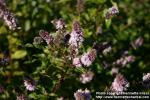Mentha Piperita (U. S. P.)—Peppermint.

 Preparations: Peppermint Water - Spirit of Peppermint - Troches of Peppermint
Preparations: Peppermint Water - Spirit of Peppermint - Troches of Peppermint
Related entries: Menthol (U. S. P.)—Menthol - Oleum Menthae Piperitae (U. S. P.)—Oil of Peppermint - Mentha Viridis (U. S. P.)—Spearmint - Oleum Menthae Viridis (U. S. P.)—Oil of Spearmint
"The leaves and tops of Mentha piperita, Smith"—(U. S. P.).
Nat. Ord.—Labiatae.
COMMON NAME: Peppermint.
ILLUSTRATION: Bentley and Trimen, Med. Plants, 203.
Botanical Source.—This herb is a perennial, with procumbent, ascending, branched, reddish stems, quite smooth, or fringed, with a few spreading hairs, furrowed and quadrangular, and 2 or 3 feet in height. The leaves are ovate-oblong, or somewhat lanceolate, rounded at the base, deep-green, smooth or hairy on the underside, serrate, and borne on ciliated petioles. The flowers are in whorls, small, and purplish; upper floral leaves small, lanceolate-subulate, shorter than the flowers. The whorls are few, lax, uppermost in a short, oblong, obtuse, reddish spike; lowermost remote, with the cymes shortly stalked. Bracts subulate, outer ones as long as the calyx. Pedicels quite smooth. Calyx 5-toothed, teeth hispid, subulate, erect. The corolla is 4-cleft, tubular, with the broadest segment emarginate. Stamens 4, awl-shaped, straight, and distant; anthers with 2 parallel cells. Achenia smooth (L.—W.—G.)
History, Description, and Chemical Composition.—Peppermint is indigenous to England, and has been extensively cultivated in various parts of Europe and throughout the United States. It grows wild in damp places and flowers from July to September. In order to preserve the fragrance of this plant, the roots require to be reset triennially, perhaps oftener. Care must also be taken to keep out the weeds, especially Erigeron canadense, Linné; Erechtites hieracifolia, Rafinesque, and Ambrosia trifida, Linné. The entire herb is medicinal; it should be collected as soon as the flowers begin to develop, and be carefully dried in the shade. The whole plant has a peculiar, aromatic, diffusive odor, and an agreeable, warm, burning, bitter taste, followed by a feeling of coolness during inhalation. These properties are more marked in the fresh than in the dried plant. Both the odor and taste are retained when the plant is dried, and may be reserved for a long time. The U. S. P. describes it as follows: "Leaves about 5 Cm. (2 inches) long, petiolate, ovate-lanceolate, acute, sharply serrate, glandular, nearly smooth, the few hairs containing crystals of menthol in one or more thin cells; branches quadrangular, often purplish; flowers in terminal, conical spikes, with a tubular, 5-toothed, often purplish calyx, a purplish, 4-lobed corolla, and 4 short stamens; odor aromatic; taste pungent and cooling"—(U. S. P). Its virtues are due to a volatile oil (see Oleum Menthae Piperitae), which is contained in little vesicles existing throughout the plant, and visible in the leaves; the oil may be obtained by distillation with water. The plant also contains tannic acid, as its infusion becomes dark-green with ferric salts. Its virtues are taken up in infusion by water, and still better by alcohol. As regards the treatment and distillation of peppermint plants, see two interesting papers by W. M. L. Weills, Proc. Penn. Pharm. Assoc., 1887, p. 147, and A. M. Todd, Amer. Jour. Pharm., 1888, p. 328.
Action, Medical Uses, and Dosage.—Peppermint is a powerful diffusive stimulant, antispasmodic, carminative, stomachic, and weak anodyne. It undoubtedly possesses marked antiseptic properties. Used in the treatment of gastrodynia, flatulent colic, hysteria, spasms or cramps of the stomach, to allay the griping of cathartics, to check nausea and vomiting, and to disguise the unpleasant taste of other medicines. Equal parts of the essence and alcohol, used by atomization, relieve the cough of bronchitis and pneumonia. The fresh herb, bruised and applied over the bowels, will often allay sick stomach, and is efficient in cholera infantum. The same kind of application sometimes relieves headache. The infusion may be drank freely; but the most usual form of administration is the essence, made by dissolving 1 fluid drachm of the oil in 1 fluid ounce of alcohol. Dose, from 10 to 60 drops, in sweetened water.
Specific Indications and Uses.—Gastrodynia, flatulent colic, and difficult digestion.

